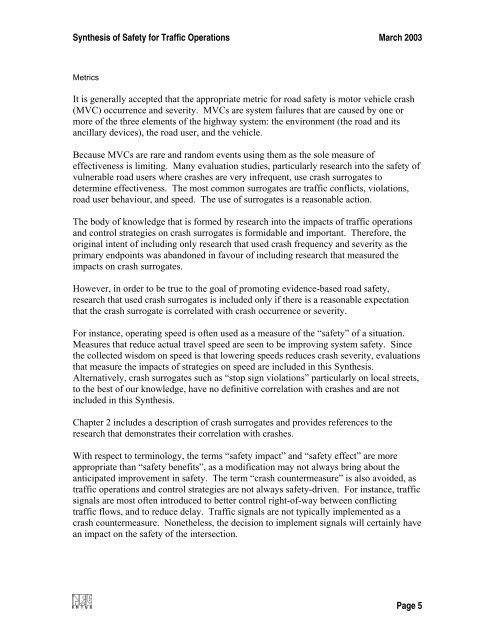Synthesis of Safety for Traffic Operations - Transports Canada
Synthesis of Safety for Traffic Operations - Transports Canada
Synthesis of Safety for Traffic Operations - Transports Canada
You also want an ePaper? Increase the reach of your titles
YUMPU automatically turns print PDFs into web optimized ePapers that Google loves.
<strong>Synthesis</strong> <strong>of</strong> <strong>Safety</strong> <strong>for</strong> <strong>Traffic</strong> <strong>Operations</strong> March 2003<br />
Metrics<br />
It is generally accepted that the appropriate metric <strong>for</strong> road safety is motor vehicle crash<br />
(MVC) occurrence and severity. MVCs are system failures that are caused by one or<br />
more <strong>of</strong> the three elements <strong>of</strong> the highway system: the environment (the road and its<br />
ancillary devices), the road user, and the vehicle.<br />
Because MVCs are rare and random events using them as the sole measure <strong>of</strong><br />
effectiveness is limiting. Many evaluation studies, particularly research into the safety <strong>of</strong><br />
vulnerable road users where crashes are very infrequent, use crash surrogates to<br />
determine effectiveness. The most common surrogates are traffic conflicts, violations,<br />
road user behaviour, and speed. The use <strong>of</strong> surrogates is a reasonable action.<br />
The body <strong>of</strong> knowledge that is <strong>for</strong>med by research into the impacts <strong>of</strong> traffic operations<br />
and control strategies on crash surrogates is <strong>for</strong>midable and important. There<strong>for</strong>e, the<br />
original intent <strong>of</strong> including only research that used crash frequency and severity as the<br />
primary endpoints was abandoned in favour <strong>of</strong> including research that measured the<br />
impacts on crash surrogates.<br />
However, in order to be true to the goal <strong>of</strong> promoting evidence-based road safety,<br />
research that used crash surrogates is included only if there is a reasonable expectation<br />
that the crash surrogate is correlated with crash occurrence or severity.<br />
For instance, operating speed is <strong>of</strong>ten used as a measure <strong>of</strong> the “safety” <strong>of</strong> a situation.<br />
Measures that reduce actual travel speed are seen to be improving system safety. Since<br />
the collected wisdom on speed is that lowering speeds reduces crash severity, evaluations<br />
that measure the impacts <strong>of</strong> strategies on speed are included in this <strong>Synthesis</strong>.<br />
Alternatively, crash surrogates such as “stop sign violations” particularly on local streets,<br />
to the best <strong>of</strong> our knowledge, have no definitive correlation with crashes and are not<br />
included in this <strong>Synthesis</strong>.<br />
Chapter 2 includes a description <strong>of</strong> crash surrogates and provides references to the<br />
research that demonstrates their correlation with crashes.<br />
With respect to terminology, the terms “safety impact” and “safety effect” are more<br />
appropriate than “safety benefits”, as a modification may not always bring about the<br />
anticipated improvement in safety. The term “crash countermeasure” is also avoided, as<br />
traffic operations and control strategies are not always safety-driven. For instance, traffic<br />
signals are most <strong>of</strong>ten introduced to better control right-<strong>of</strong>-way between conflicting<br />
traffic flows, and to reduce delay. <strong>Traffic</strong> signals are not typically implemented as a<br />
crash countermeasure. Nonetheless, the decision to implement signals will certainly have<br />
an impact on the safety <strong>of</strong> the intersection.<br />
Page 5
















